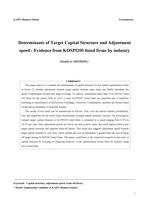

-
미리보기
목차
1. Introduction
2. Methodology
3. Data
4. Empirical Test Results
5. Summary and Conclusions
6. Reference본문내용
A variety of capital structure theory could be representatively divided into trade-off theory, pecking order theory, and market timing theory.
Firstly, the pioneers of the trade-off theory are Modigliani and Miller (1963), who analyzed capital structure decisions in a model with taxes. The trade-off theory implies firms identify their optimal leverage by weighing the costs and benefits of an additional debt. That is, the companies increase debt levels until the marginal benefits of debt equals the marginal cost of debts. And, this point is optimal capital structure which maximizes firm value. For reference, benefit of additional debt is that firm can profit more from debt tax shields, which will increase its value. On the other hand, costs of additional debt are higher probability of financial distress and agency conflicts between stockholders and bondholders (Fama and French, 2002).참고자료
· Antoniou, Antonios, Yilmaz Guney and Krishna Paudyal, 2008, The Determinants of Capital Structure: Capital Market-oriented versus Bank-oriented Institutions, Journal of Financial and Quantitative Analysis 43, 59-92
· Baker, Malcolm, and JeffreyWurgler, (2002), Market timing and capital structure, Journal of Finance, 57, 1–30.
· Booth, l., Aivazian V., Demirguc-kunt a. and Maksimovic, V. (2001). Capital structures in developing countries, Journal of Finance, 56, pp87-130.
· DeAngelo, H., and Masulis, R.W.(1980), Optimal capital structure under corporate and personal taxation, Journal of Financial Economics, 8, pp.3-29.
· Dierker et al.(2013), Do Firms Adjust Capital Structure to Manage Risk?, Working paper
· Donaldson G. (1961) Corporate Debt Capacity: A study of Corporate Debt Policy and the Determination of Corporate Debt Capacity, Boston, Division of Research, Harvard Graduate School of Business Administration
· Fama, E., French, (2002), Testing trade-off and pecking order predictions about dividends, Review of Financial Studies, 15, p 1-33.
· Flannery and Rangan(2006), Partial adjustment toward target capital structures, Journal of Financial Economics
· Getzmann, A., Lang, S. and Spremann, K., (2010). 'Determinants of the target capital structure and adjustment speed-evidence from Asian capital market'. Working paper
· Hass and Peeters (2006), The dynamic adjustment towards target capital structure of firms in transition economies, Economics of Transition Volume 14 (1) pp.133-169
· Homaifar, G., J. Zietz and O. Benkato (1994), `An Empirical Model of Capital Structure: Some New Evidence', Journal of Business Finance & Accounting, Vol. 21, No. 1 (January), pp. 1-14.
· Hovakimian, Opler and Titman(2001), The debt-equity choice, Journal of Financial and Quantitative Analysis, 36, 1-24
· Jensen, M.,(1986), Agency costs of free cash flow, corporate finance and takeovers, American Economic Reviews, 76, pp 323-339.
· Kang and Lee(2013), A Study on the Effects of Firm Size and Financial Constraints on Adjustment Speed of Capital Structure, The Korean Journal of Financial Engineering, Vol. 12, pp. 123~147
· Kim H.S., A. Heshmati and D. Aoun (2006), “Dynamics of Capital Structure: The Case of Korean Listed Manufacturing Companies”, Asian Economic Journal 20(3), 275-303.
· Modigliani, F, and Miller, M H,(1958) “The Cost of Capital, Corporation Finance, and the Theory of
· Investment” American Economic Review, VO1.XLVIII, No.3, pp.261-97,
· Modigliani, F. and Miller, M. H. (1963). Corporate Income Taxes and the Cost of Capital: A Correction. American Economic Review, 53, 433-43
· Michael R. Roberts (2002), The Dynamics of Capital Structure: An Empirical Analysis of a Partially Observable System, Duke Working paper
· Myers, SC, “The Capital Structure Puzzle” Journal of Finance VO1.XXXIX, No.3 (July 1984), pp.575-92
· Ozkan, A. (1996), Corporate Bankruptcies, Liquidation Costs and the Role of Banks, The Manchester School, Vol. 64, pp. 104-19.
· Ozkan, A. (2001). “Determinants of Capital Structure and Adjustment to Long Run Target: Evidence from UK Company Panel Data,” Journal of Business Finance & Accounting, 28, 175-198.
· Rajan, R. and L. Zinglales, (1995), What do we know about capital structure? Some evidence from international data, Journal of Finance, 50, pp1421-1460.
· Taggart(1977), A model of corporate financing decisions, Journal of Finance, Vol. 32. No.5 pp. 1467-1484
· Titman, S. and R. Wessels(1988), The determinants of capital structure choice, Journal of Finance, 43, pp.1-19
· Worthington, P.R.(1995), Investment, cash flow, and sunk costs, Journal of Industrial Economics, 43, pp.49-61태그
-
자료후기
Ai 리뷰지식판매자가 등록한 자료는 매우 유익하고, 주제가 잘 정리되어 있어 학습에 큰 도움이 됩니다. 특히 자료의 품질이 높고, 내용이 풍부하여 많은 정보를 얻을 수 있었습니다. 앞으로도 이러한 유익한 자료가 계속 등록되기를 기대합니다! -
자주묻는질문의 답변을 확인해 주세요

꼭 알아주세요
-
자료의 정보 및 내용의 진실성에 대하여 해피캠퍼스는 보증하지 않으며, 해당 정보 및 게시물 저작권과 기타 법적 책임은 자료 등록자에게 있습니다.
자료 및 게시물 내용의 불법적 이용, 무단 전재∙배포는 금지되어 있습니다.
저작권침해, 명예훼손 등 분쟁 요소 발견 시 고객센터의 저작권침해 신고센터를 이용해 주시기 바랍니다. -
해피캠퍼스는 구매자와 판매자 모두가 만족하는 서비스가 되도록 노력하고 있으며, 아래의 4가지 자료환불 조건을 꼭 확인해주시기 바랍니다.
파일오류 중복자료 저작권 없음 설명과 실제 내용 불일치 파일의 다운로드가 제대로 되지 않거나 파일형식에 맞는 프로그램으로 정상 작동하지 않는 경우 다른 자료와 70% 이상 내용이 일치하는 경우 (중복임을 확인할 수 있는 근거 필요함) 인터넷의 다른 사이트, 연구기관, 학교, 서적 등의 자료를 도용한 경우 자료의 설명과 실제 자료의 내용이 일치하지 않는 경우
문서 초안을 생성해주는 EasyAI

